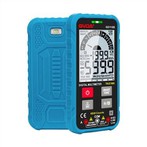When measuring capacitance with a multimeter, why is there no response?
If the digital multimeter measures the capacitance, there is no response. First, make sure the gear position and jack are correct, and secondly, the multimeter is not broken. This kind of low-level error generally does not go out. If the multimeter is normal and the settings are correct, then the capacitor is most likely broken. When the capacitor is internally damaged due to an open circuit (burned out), the multimeter displays zero.
Another possibility is that when using a multimeter to measure capacitance, the electricity in the capacitor must be discharged first, otherwise the internal components of the multimeter may be damaged. For small-capacity capacitors, simply short-circuit the two pins of the capacitor. Do not directly short-circuit large-capacity capacitors or cables when they are discharging, otherwise the huge heat generated by the short-circuit will cause the capacitor to bulge or even explode. The correct approach is to connect a resistor or electrical device to both ends of the capacitor and let the resistor or electrical device consume the power.
(When selecting electrical equipment, you must ensure that the rated voltage of the electrical equipment is higher than the capacitor voltage.)
pointer multimeter
1. If you are using an analog multimeter, it is possible that the capacitor range is too large. The capacitance setting and point resistance setting of the analog multimeter are integrated. The larger the resistance setting, the smaller the capacitance setting.
2. Another situation is that the capacitor is damaged. When the capacitor is internally open-circuited (disconnected), the multimeter pointer will have no response. When the capacitor is internally short-circuited (short-circuited), the multimeter pointer will always stop at the zero mark of the resistor.
Under normal circumstances, when using a pointer multimeter to measure capacitance, the pointer will deflect to the right quickly, then slowly move back, and finally stop at a certain position. The larger the capacitor capacity, the larger the pointer's deflection angle to the right; the better the capacitor quality, the closer the pointer's final stop position is to infinity.
3. Another problem is that the capacitor is not discharged. Use a pointer multimeter to measure the capacitance. Every time you need to re-measure the capacitance, you must re-discharge (short-circuit it). Some friends said that I discharged my electricity the first time, didn't I? Because every time you use the capacitance setting (actually the resistance setting) to measure the capacitance, the battery inside the multimeter will charge the capacitance. Therefore, the capacitor must be short-circuited every time the measurement needs to be re-measured.





